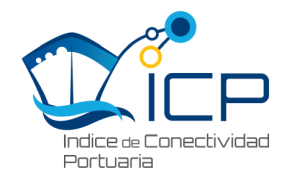
The ICP measures the connectivity of Short Sea Shipping (TMCD) traffic for containerized goods from Spanish ports.
The new index is jointly developed by the PAV and the Valenciaport Foundation and for its elaboration the UNCTAD connectivity index has been taken as a reference.
The results of the ICP in the second semester of 2018 give Valenciaport the best score of the whole of the Spanish port system followed by the port of Algeciras and the port of Barcelona.
València, March 28, 2019.- The Port Authority of Valencia (PAV) and the Valenciaport Foundation have presented this morning the Index of Connectivity of the Spanish Ports (ICP), an indicator that will allow to measure and monitor maritime connectivity. This variable is key for assessing port competitiveness, as pointed out by Aurelio Martínez during the presentation he has made in the framework of the session “Connectivity and Competitiveness” and in which Amparo Mestre, from the Valenciaport Foundation and Jan Hoffmann, from UNCTAD had participated too.
During the session, held at the Clock Building of the port of Valencia, Aurelio Martínez has highlighted the work developed jointly by the APV and the Valenciaport Foundation and has resulted in an indicator that “will allow us to measure the connectivity and competitiveness of the Spanish ports, generating advantages for the importers and for the economic sector of the country”.
As pointed out by Aurelio Martínez, this indicator, which is calculated on a biannual basis, is developed using a methodology similar to the used by UNCTAD, applied exclusively to regular short sea shipping (TMCD) services. Also, as explained by Aurelio Martínez, the ICP is an indicator “on the supply side, so it measures the connectivity services provided by each port, which does not mean that demand is adjusted”. The president of the PAV has highlighted that for its elaboration the connectivity index of the first semester of 2016 has been taken as base 100 and has been applied to the main ports of the Spanish port system, specifically the first 10.
The president of the PAV has also indicated that in the future it is planned to work on some lines that help to complete the ICP. Among them has highlighted the application of the index to the western Mediterranean; the introduction of methodological improvements following the work of UNCTAD; or the application of connectivity analysis to all traffics among others.
During the meeting, Aurelio Martínez presented the results of the ICP index for the second half of 2018. These data place Valenciaport as the first port in terms of connectivity and maritime competitiveness with a score of 97.31, followed by the ports of Algeciras (83.85). and Barcelona (83.57).
These results are published every semester on the Valenciaport website (business section) together with other indicators.
ICP: Methodology and database
During her speech, Amparo Mestre, head of R + D + I projects at the Valenciaport Foundation, was in charge of presenting the work carried out by the Valenciaport Foundation for the development of the connectivity index. Mestre stressed that “in the port area, connectivity determines in a decisive way port competitiveness, since ports are facilitators of trade and economic growth”.
The ICP analyzes seven variables: the TCMD services, the container traffics operating in Spanish ports, the companies that offer these services, the attached vessels, the tons that are being handled, the maximum size of the vessels, the frequency and the number of directly connected ports. The connectivity index is based on objective data since the primary source for its preparation are shipping lines and the existing supply.
Finally, Jan Hoffmann explained that UNCTAD has been measuring port connectivity for 15 years. In this regard, he stressed that “the World Bank studies explain that the increase in competition leads to a decrease in the cost of freight”.
Valenciaport and TMCD
Valenciaport maintains a firm commitment to short sea shipping, being a leader in Spain in regular connections with Mediterranean countries, the North Sea and the Baltic. Especially relevant are the motorways of the sea that connect the ports of Valencia and Sagunto with ports in northern and southern Italy.
The ro-ro traffic presents a great potential for Valenciaport as it annually represents more than 200,000 platforms transported between the ports of Valencia and Sagunto. In addition, automobiles, this type of traffic is used by goods such as oil, wine, machinery, packaged food products or refrigerated products.
Valenciaport currently has 7 regular short sea shipping (TMCD) ro-ro services that connect it with 24 ports in 15 different countries. In 2018, Valenciaport handled 9.45 million tons of ro-ro traffic, which represents an increase of 25% compared to the previous year. In terms of UTI, in 2018, 421,191 ICUs were channeled, 22% more than in 2017.

